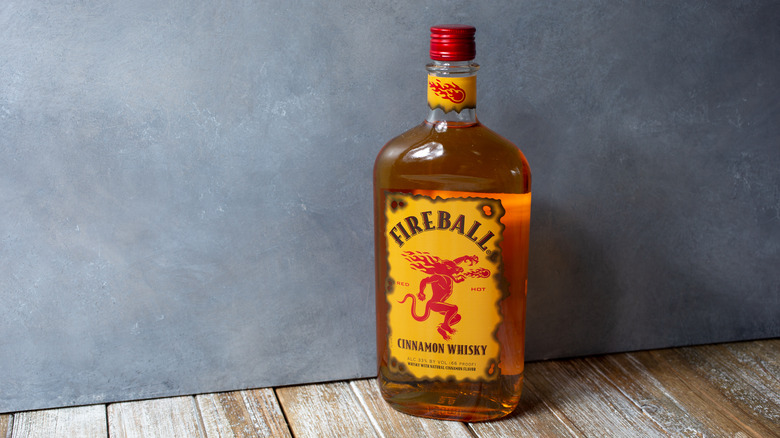What's Really In Fireball Whisky?
Some cringe at its mere mention of it, while others feel their senses burn with the light of a thousand suns. Yes, you're correct: It's Fireball Whisky, and it's perhaps the most divisive spirit on the market. Emblazoned with the image of what, by all accounts — so, our account — appears to be a demonic dragon rising from a fiery underworld, Fireball's tagline is appropriately poetic: "Tastes Like Heaven, Burns Like Hell." But what ingredients are used to conjure the toil and trouble within each bottle? Does the demonic dragon simply dip its chalice into a lake of fire and thusly seal it shut with the heat of its Dantean clawed talon? Or — in a fashion that's somehow converse yet completely alike — are the contents likely from a food laboratory than the devil's playground?
The spirit was not conjured up in the fires of hell. (We think.) (Mostly.) Instead, according to Liquor.com, it's a Canadian product, first distilled in the Great White North during a cold winter in the mid-1980s. There it existed as Canada's little secret for more than a decade, where it was branded as Dr. McGillicuddy's Fireball Cinnamon Whisky. After making its U.S debut around 2001, it was later rebranded as Fireball Whisky in 2007.
From there, Fireball caught on like, well, wildfire. According to Business Insider, by 2011, Fireball accounted for $1.9 million in retail sales — and in 2013, Fireball blew up. Sales numbers exploded to $61 million without even factoring in shots sold at bars. So, how did it happen?
The Fireball Whisky flavor profile
For many, a quick sniff of Fireball is enough to reveal what flavors the makers are trying to incorporate. The initial note is reminiscent of Big Red gum or Atomic Fireball candies — a cinnamon singe in the nostrils giving your palate a clue to the pleasures to come. It's actually a correct estimation; according to the brand's website, Fireball Whisky is made with real cinnamon. This warm pantry spice imparts an aromatic, spicy flavor, with woody notes and a peppery pungency that lingers on the tongue.
It's likely this spicy cinnamon that gives Fireball its unrelenting fanbase. Along with the clearly alluring branding and aesthetic, the cinnamon-tinged spiciness imbued in every bottle delivers that hit of heat.
But unlike chili peppers, whose heat originates in a chemical called capsaicin, cinnamon owes its spicy reputation to high levels of cinnamaldehyde and eugenol. Though this doesn't make cinnamon register on the infamous Scoville scale, these compounds bring a heat similar to that of horseradish and wasabi.
Okay, so what's really in Fireball Whisky?
At 33% alcohol by volume (or ABV), Fireball Whisky amounts to a cinnamon-tinged kick to the teeth. If you look closely at the label of Fireball Whisky you'll see the note: "Whisky with Natural Cinnamon Flavor." This means that while you won't find any cinnamon sticks floating in the bottle, the natural flavoring derived from cinnamon is there to carry the load. Before cinnamon, Fireball is made with a base foundation of Canadian whiskey. Flavoring is added to that barrel-aged spirit, along with more sugar than you'd think.
So, to wit, just how much sugar is in Fireball Whisky? Well, it's a lot. A lot. Quite a lot. Just one shot of fireball contains 11 grams of sugar.
Let's break that down a bit. A standard shot glass can hold around 1.5 ounces of booze. The 11 grams of sugar in a shot of Fireball accounts for 0.38 ounces — that means ¼ of the shot is pure sugar, according to the site Drink Spirits. With that in mind, it's easy to see why Fireball Whisky is so popular: sugar, spice, and everything nice.


